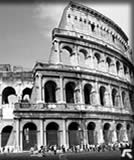 |
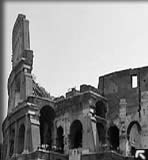 |
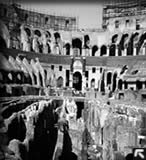 |
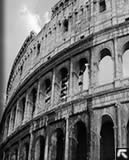 |
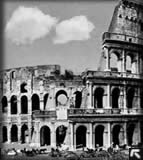 |
|||||
The Roman Colosseum: Glossary
| Word | Definition |
| Awning/Valerium | 1. a rooflike shelter of canvas or other material extending over
a doorway, from the top of a window, over a deck, etc., in order
to provide protection, as from the sun. 2. a shelter. |
| Cavea | 1. In Roman times the cavea were the subterranean cells in which
wild animals were confined before the combats in the Roman arena
or amphitheatre. 2. The cavea was where the spectators sat according to their place in the social hierarchy. |
| Chamber | A room where a person of authority, rank, or importance receives visitors; an enclosed space or compartment. |
| Colosseum | An amphitheater, stadium, large theater, or other special building for public meetings, sporting events, exhibitions, etc. |
| Corinthian | Architecture. noting or pertaining to one of the five classical orders invented in ancient Greece and similar in most respects to the Ionic but usually of slenderer proportions, and characterized by a deep capital with a round bell decorated with acanthus leaves and a square abacus with concave sides. The Corinthian capital has typically two distinct rows of acanthus leaves above which appear eight fluted sheaths, from each of which spring two scrolls (helices), of which one curls beneath a corner of the abacus as half of a volute and the other curls beneath the center of the abacus |
| Doric | Architecture. noting or pertaining to one of the five classical orders, developed in Greece and altered by the Romans. The Greek Doric order consists typically of a channeled column without a base, having as a capital a circular echinus supporting a square abacus, above which come a plain architrave, a frieze of triglyphs and metopes, and a cornice, the corona of which has mutules on its soffit. In the Roman Doric order, the columns usually have bases, the channeling is sometimes altered or omitted, and the capital usually consists of three parts: a thick, bandlike necking, an echinus with an ovolo outline, and a molded abacus. |
| Facade | Architecture. a. the front of a building, esp. an imposing or decorative one. b. any side of a building facing a public way or space and finished accordingly. |
| Ionic | Architecture. noting or pertaining to one of the five classical orders that in ancient Greece consisted of a fluted column with a molded base and a capital composed of four volutes, usually parallel to the architrave with a pulvinus connecting a pair on each side of the column, and an entablature typically consisting of an architrave of three fascias, a richly ornamented frieze, and a cornice corbeled out on egg-and-dart and dentil moldings, with the frieze sometimes omitted |
| Naval | 1. of or pertaining to warships: a naval battle; naval strength. 2. of or pertaining to ships of all kinds: naval architecture; naval engineer. 3. belonging to, pertaining to, or connected with a navy: naval affairs. |
| Podium | 1. a small platform for the conductor of an orchestra, for a public
speaker, etc. 2. Architecture. a. a low wall forming a base for a construction, as a colonnade or dome. b. a stereobate for a classical temple, esp. one with perpendicular sides. c. the masonry supporting a classical temple. d. a raised platform surrounding the arena of an ancient Roman amphitheater having on it the seats of privileged spectators. |
| Stadium | a sports arena, usually oval or horseshoe-shaped, with tiers of seats for spectators |